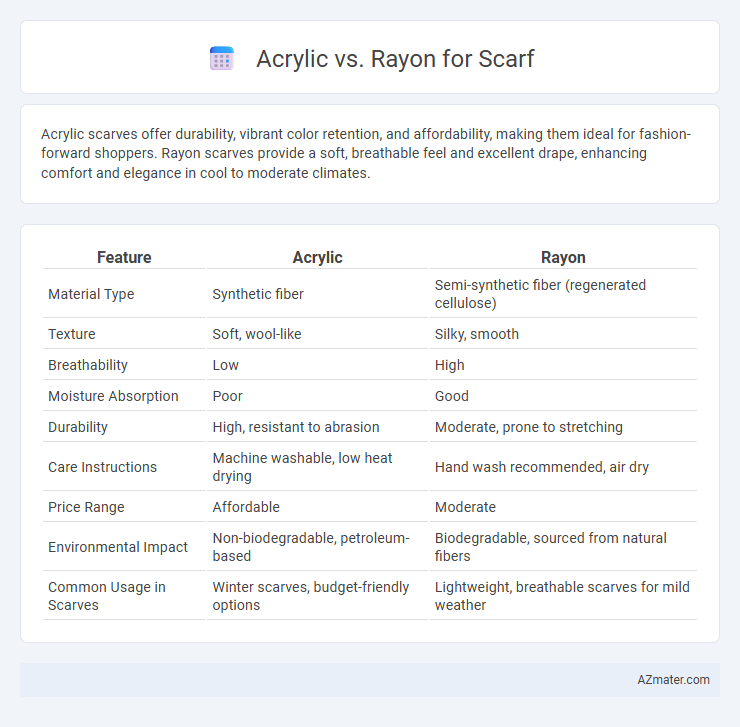Acrylic scarves offer durability, vibrant color retention, and affordability, making them ideal for fashion-forward shoppers. Rayon scarves provide a soft, breathable feel and excellent drape, enhancing comfort and elegance in cool to moderate climates.
Table of Comparison
| Feature | Acrylic | Rayon |
|---|---|---|
| Material Type | Synthetic fiber | Semi-synthetic fiber (regenerated cellulose) |
| Texture | Soft, wool-like | Silky, smooth |
| Breathability | Low | High |
| Moisture Absorption | Poor | Good |
| Durability | High, resistant to abrasion | Moderate, prone to stretching |
| Care Instructions | Machine washable, low heat drying | Hand wash recommended, air dry |
| Price Range | Affordable | Moderate |
| Environmental Impact | Non-biodegradable, petroleum-based | Biodegradable, sourced from natural fibers |
| Common Usage in Scarves | Winter scarves, budget-friendly options | Lightweight, breathable scarves for mild weather |
Introduction: Acrylic vs Rayon for Scarves
Acrylic scarves offer durability, vibrant color retention, and affordability, making them a popular choice for everyday wear. Rayon scarves provide a soft, lightweight feel with a smooth, silky texture, enhancing comfort and elegance. Choosing between acrylic and rayon depends on preferred warmth, texture, and maintenance requirements.
Material Composition and Origin
Acrylic scarves are made from synthetic polymers derived primarily from petroleum-based chemicals, providing durability and resistance to moisture. Rayon scarves originate from regenerated cellulose fibers sourced from natural materials like wood pulp, offering a softer and more breathable texture. The material composition directly influences scarf care, texture, and environmental impact, with acrylic leaning toward synthetic resilience and rayon toward natural fiber comfort.
Texture and Feel on the Skin
Acrylic scarves offer a soft, wool-like texture that is lightweight and warm but can sometimes feel slightly synthetic against sensitive skin. Rayon scarves provide a smooth, silky feel with excellent breathability, making them gentle and comfortable for prolonged wear. Choosing between acrylic and rayon depends on whether you prefer the cozy warmth of acrylic or the cool, sleek touch of rayon on your skin.
Durability and Longevity
Acrylic scarves offer excellent durability due to their resistance to wear, moisture, and fading, making them ideal for long-term use without significant deterioration. Rayon scarves, though softer and more breathable, tend to be less durable and may weaken or lose shape after repeated washing and prolonged exposure to moisture. Choosing acrylic ensures a scarf that maintains its appearance and strength over time, while rayon requires more delicate care to preserve longevity.
Warmth and Breathability
Acrylic scarves provide excellent warmth due to their insulating synthetic fibers, making them ideal for cold weather. Rayon scarves offer superior breathability because the natural cellulose fibers allow better air circulation, keeping the wearer comfortable in milder conditions. Choosing between acrylic and rayon depends on the desired balance of heat retention and ventilation for scarf use.
Color Retention and Dyeability
Acrylic fibers exhibit excellent color retention due to their synthetic composition, which allows them to hold vibrant dyes without significant fading over time. Rayon, being a semi-synthetic fiber derived from cellulose, offers superior dyeability with a wide range of colors and a soft, lustrous finish but may experience some color fading with frequent washing or exposure to sunlight. For scarves requiring vivid, long-lasting colors, acrylic provides durability in color retention, whereas rayon offers richer dye saturation but demands more delicate care to maintain its hue.
Ease of Care and Maintenance
Acrylic scarves are highly resistant to wrinkles, shrinking, and stains, making them easier to care for with simple machine washing and quick drying properties. Rayon scarves, while soft and breathable, typically require gentle hand washing or dry cleaning to maintain their delicate fibers and vibrant colors. Choosing acrylic reduces time and effort in maintenance, whereas rayon demands a more careful approach to preserve fabric quality.
Price Comparison
Acrylic scarves are generally more affordable than rayon alternatives, with prices often ranging from $10 to $30 compared to rayon scarves, which typically cost between $20 and $50. Acrylic fibers are mass-produced at a lower cost, making them a budget-friendly option for scarves, whereas rayon requires a more complex production process involving natural cellulose, driving up its price. Consumers looking for economical scarves tend to favor acrylic for its cost-effectiveness without compromising on warmth and color variety.
Environmental Impact
Acrylic scarves are derived from synthetic polymers, contributing to microplastic pollution and a higher carbon footprint due to petroleum-based production processes. Rayon, though semi-synthetic and made from cellulose fibers, involves chemically intensive manufacturing that can lead to water pollution unless treated responsibly. Choosing environmentally friendly scarf options requires considering biodegradability, chemical usage, and the overall sustainability of production methods.
Choosing the Best Material for Your Scarf
Acrylic scarves offer durability, vibrant color retention, and affordability, making them ideal for everyday wear and easy maintenance. Rayon scarves provide a smooth, silk-like texture and excellent breathability, enhancing comfort and elegance for special occasions. Choosing the best material depends on your preference for warmth, softness, and care requirements in your scarf.

Infographic: Acrylic vs Rayon for Scarf
 azmater.com
azmater.com